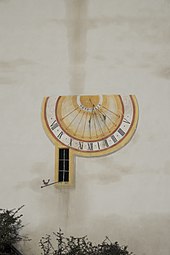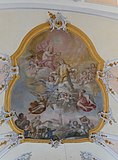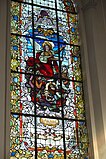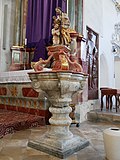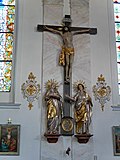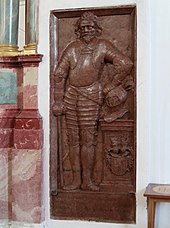St. Laurentius (Pähl)
The Catholic parish church of St. Laurentius in Pähl , a municipality in the Upper Bavarian district of Weilheim-Schongau , is originally a Romanesque church, which was followed by a new Gothic- style building in the 15th century . The present church was essentially built in the 18th century according to plans by Joseph Schmuzer . The church dedicated to the martyr Lawrence of Rome is a protected architectural monument .
history
The first mention of the Pähl parish is documented for 1159. Only the basement of the tower remains of the Romanesque church of that time . In the early 15th century, a new Gothic style church was built, which was consecrated in 1414 by the Augsburg Bishop Anselm von Nenningen . In 1596 the dilapidated nave was renewed and in 1613 the tower received its octagonal structure and onion dome after a storm damage . In 1723 a new nave was built according to plans by Joseph Schmuzer and the old choir , taken over from the Gothic church, was redesigned. In 1734 the new church was consecrated by the Augsburg Prince-Bishop Alexander Sigismund von der Pfalz . In 1765 the so-called crypt chapel was added to the southern nave and between 1770 and 1772 the church was designed in the late Rococo style .
architecture
Exterior construction
In the southern corner of the choir is the bell tower, the square base of which goes back to the Romanesque predecessor church. A sundial is painted on its south side and a clock is attached higher up. Under the octagonal structure, round-arched twin arcades resting on central posts are cut on all four sides . The chapel extension on the south side, the so-called crypt chapel , is covered by a pent roof. The high arched windows of the nave are framed by recessed rectangular panels. In the northern corner of the choir, the two-storey sacristy is connected to the outer staircase to the pulpit .
inner space
The single-nave nave is divided into four axes and is covered by a flat needle cap barrel that rests on double pilasters . The retracted choir is one step higher and is closed on three sides. It is also covered by a needle cap barrel - albeit over simple pilasters. A double gallery forms the western end of the nave .
Frescoes
The ceiling paintings depict scenes from the vitae of the church patron. They were executed by Johann Baptist Baader , a painter from Lechmühlen, now part of the municipality of Fuchstal , who is also known under the name "Lechhansl". The choir fresco depicts the glory of St. Lawrence who is crowned by Christ. The grate on which he suffered his martyrdom can be seen at the saint's feet. At the lower edge of the picture the church of Pähl is shown, surrounded by beggars and needy people who beg Laurentius for help.
On the nave fresco, Laurentius stands in front of Emperor Valerian in the midst of a monumental architectural backdrop . The upper part of the picture, surrounded by angels, is occupied by the Trinity , the female figures floating below on clouds hold the symbols of the divine virtues in their hands, an anchor and a flowering branch as a symbol of hope, the burning heart as a sign of love, the chalice over which a host hovers and the cross as a sign of faith. Next to it, an angel presents the tablets of the law. On the lower image level, torturers are already lighting the fire under the grate on which Laurentius will be martyred. The painter's signature can be read on the lower right edge: “BaaDer LeChMVLLanVs PInXIt”. The letters DLCMVLLVIXI are highlighted in color, they result in a chronogram with the year 1772, the year the frescoes were completed.
The tone-on-tone paintings of the lateral rocaille cartouches take up themes from the Old Testament , the northern scene shows Daniel in the lions' den and the southern scene shows the three young men in the fiery furnace.
The fresco above the gallery depicts the departure of St. Lawrence from Pope Sixtus II , who is to be executed on the orders of Emperor Valerian .
The fresco on the lower gallery parapet is also by Johann Baptist Baader. One sees St. Lawrence dividing the church treasure among the poor.
Piece
The stucco decoration in the late Rococo style was executed around 1772 and is attributed to Johann Michael Merk (or Merck). A clock is emblazoned on the choir arch, framed by a magnificent cartouche . The nave is decorated with numerous winged angel heads and rocaille cartouches, which also surround the Apostle candlesticks , as well as the symbolic representations of the divine virtues and the four seasons.
Leaded glass window
The leaded glass windows in the nave were made in 1888 and 1889 by F. Dorn in Munich. The windows bear the signature of the stained glass, the inscriptions contain the year of their creation and the names of the donors: Pastors Mathias Burkart, Augustin and Crescenzia Günther, Sebastian and Rosina Happach. Saints like Saint George , Archangel Michael and Saint Francis Xavier are depicted on the windows . One window shows St. Crescentia with her protégé, St. Vitus , and her husband, St. Modestus . Another window is dedicated to St. Monica , mother of St. Augustine . Another window is about the legend of Augustine and the boy by the sea . A boy, represented as an angel with wings, tries to scoop out the sea with a shell. When Augustine points out to him the impossible of his plan, the boy replies that he can do this sooner than Augustine can fathom the mysteries of the Trinity.
The leaded glass windows in the crypt chapel were executed in 1897 by the glass painting company Ostermann & Hartwein in Munich.
organ
The organ was built in 1846 by Johann Georg Beer from Erling with 20 stops on two manuals and a pedal . The disposition is:
|
|
|
|||||||||||||||||||||||||||||||||||||||||||||||||
- Coupling : II / I, I / P
- Playing aids: mechanical transposition system (semitone lower), stop valves for individual registers
- Comments: sliding drawer, mechanical game and stop action, free-standing game table
Furnishing
- The pulpit is marked with the year 1773. The pulpit is decorated with putti , in the middle the brazen serpent and the tablets of the law are shown. On the sound cover you can see a trumpet angel, below it angel heads and on the edge the evangelist symbols .
- The baptismal font with the group of figures depicting the baptism of Jesus is dated to the late 17th century.
- The late Gothic crucifix on the south wall of the nave dates from the 16th century , the assistant figures were probably added in the 17th century.
- A Pietà from around 1440 stands on a stone pedestal on the east side of the crypt chapel .
- In the crypt chapel, a copy is reminiscent of the so-called Pähler Altar , a winged altar from around 1400, which originally stood in the George Chapel in the Hochschloss in Pähl and is now kept in the Bavarian National Museum in Munich. The original, after which the master of the Pähler Altar got his emergency name , is a tempera painting on canvas with a punched gold ground. The middle picture shows the crucifixion of Christ with Mary and John the Evangelist , on the inside of the side wings you can see St. Barbara with her attribute , the tower, and John the Baptist , who points to the sacrificial lamb . The outer sides of the wings depict a Madonna and Child and the Man of Sorrows .
Epitaphs
Gravestones and epitaphs made of red marble are set into the walls in the choir and under the gallery . They date from the 16th to 18th centuries and are reminiscent of pastors and the family of the Lords of Berndorf.
literature
- Georg Dehio : Handbook of German Art Monuments - Bavaria IV - Munich and Upper Bavaria . 2nd edition, Deutscher Kunstverlag , Munich 2002, ISBN 3-422-03010-7 , p. 941.
- Karin Hösch: Pähl St. Laurentius . Pfarramt Pähl (ed.), Peda-Kunstführer No. 414, Passau 1997, ISBN 3-89643-070-X .
- Georg Paula , Stefanie Berg-Hobohm : District Weilheim-Schongau (= Bavarian State Office for Monument Preservation [Hrsg.]: Monuments in Bavaria . Volume I.23 ). Lipp, Munich 2003, ISBN 3-87490-585-3 , pp. 200-203 .
Web links
Individual evidence
- ^ Parish of St. Laurentius - Pähl Diocese of Augsburg
- ↑ Bavarian organ database online
Coordinates: 47 ° 54 ′ 21.6 " N , 11 ° 10 ′ 39.4" E


